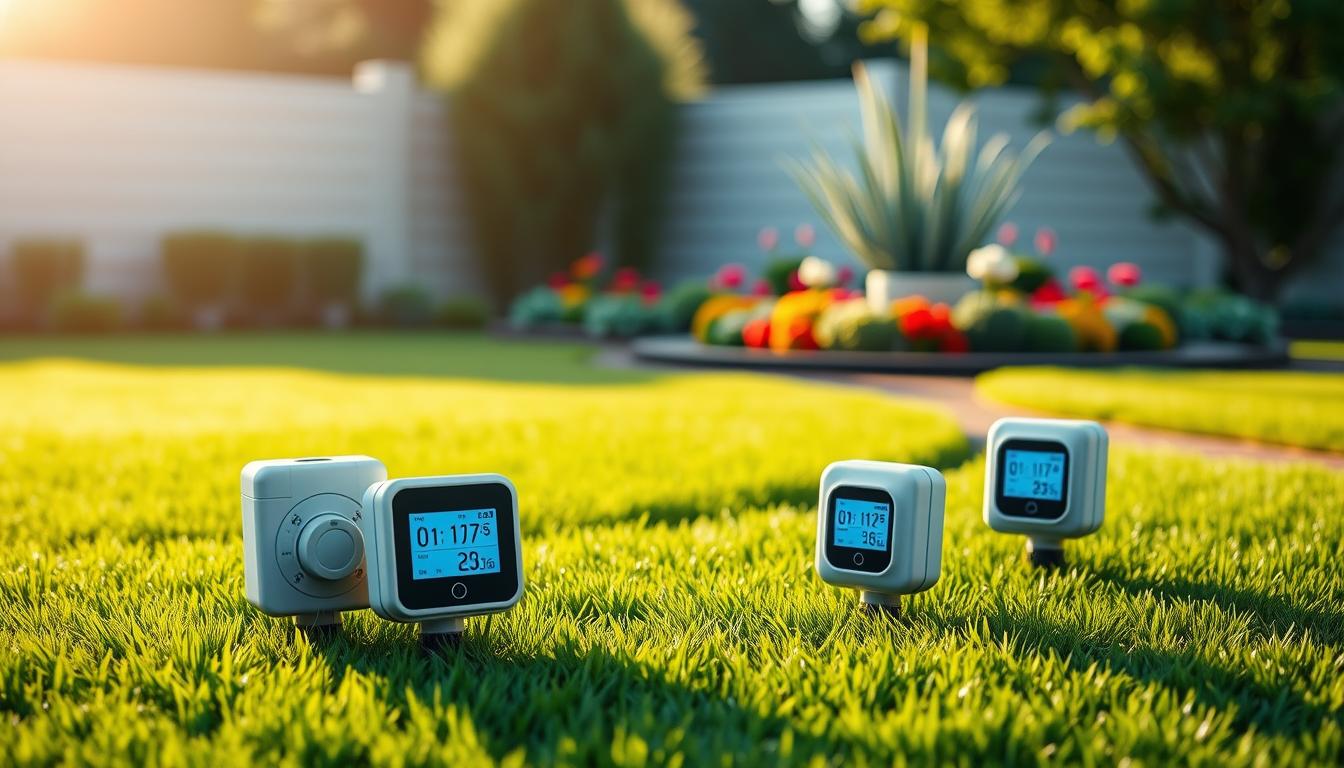Do you remember dragging hoses or waking up early to adjust sprinklers? Those days are fading away. Homeowners now use smart watering timers to save time, money, and water.
Modern irrigation controllers are a game-changer for lawn care. They work with your sprinkler system but offer more than traditional timers. They bring intelligence to your lawn care.
These systems are amazing because they adjust to your lawn’s needs. They watch the weather, soil, and seasons to water just right. Your grass stays green, and you use up to 50% less water.
Smart watering timers are for everyone, whether you love tech or just want a nice yard. They’re a smart choice for every home.
The Hidden Cost of Traditional Lawn Watering
Keeping your lawn green costs more than just your water bill. Old ways of watering can hurt your wallet, the environment, and waste resources. As water gets scarcer, knowing these hidden costs is key for smart homeowners.
Water Waste Statistics in American Households
Our lawn watering habits are shocking. The average home uses 320 gallons of water daily, with 30% going outside. Sadly, up to 50% of this water is lost due to bad irrigation.
Old sprinkler systems waste water to evaporation, runoff, and wind. The EPA found that one home can waste 25,000 gallons a year. That’s enough to fill a pool.
Environmental Impact of Overwatering
Too much water on lawns harms our ecosystem. When lawns get too wet, runoff carries harmful chemicals into waterways.
This runoff causes algae blooms and messes up aquatic life. It also makes lawns more prone to disease and drought. This creates a cycle of needing even more water.
Rising Utility Bills and Water Restrictions
Water prices keep going up. Rates have risen 5% a year for a decade, faster than inflation. In dry areas, using a lot of water costs a lot more.
Water limits are getting stricter everywhere. Now, you can only water outside on certain days and times. Breaking these rules can lead to big fines. As climate change worsens, these rules will only get tougher.
| Impact Area | Traditional Watering | Smart Water Management | Potential Savings |
|---|---|---|---|
| Water Usage | 25,000+ gallons wasted annually | Precision watering based on needs | Up to 50% reduction |
| Environmental Effect | Chemical runoff, shallow root systems | Minimal runoff, healthier plants | Reduced pollution, stronger ecosystem |
| Financial Impact | Rising bills, potential fines | Optimized water consumption | $200-$300 annually |
| Compliance | Manual adjustments for restrictions | Automatic compliance with local rules | Avoided penalties, less hassle |
Smart Watering Timers: The Future of Lawn Irrigation
Smart watering timers have changed the game in home lawn care. They make irrigation more efficient and cut down on waste. These systems offer precision and ease that old methods can’t match.
Definition and Basic Functionality
Smart watering timers, or intelligent irrigation timers, control your lawn’s water. They don’t just turn water on and off like old timers. They use real-time data to make smart decisions.
These timers connect to your irrigation system but add a smart twist. They check the weather, soil moisture, and plant needs to set the best watering times. Many can be controlled through apps, letting you manage your lawn from anywhere.
Evolution from Traditional Timers
The shift from simple timers to smart systems took decades. Early timers were just clocks that watered at set times. Later, they became programmable but still didn’t know the weather.
Now, smart timers are a huge leap ahead. They watch the environment and adjust watering based on it. This has cut down on water waste and made plants healthier.
Core Technologies Behind Smart Irrigation
Modern smart watering systems use several key technologies. Weather sensors track rain, temperature, and humidity. This way, they know when to skip watering.
Soil moisture sensors check how wet the soil is. This ensures plants get the right amount of water. Wi-Fi, Bluetooth, and cellular networks let you control them from afar. The smart algorithms analyze all this data to make the best watering decisions.
These technologies work together to create automated watering that adapts to your lawn’s needs. It’s a smarter, more sustainable way to water your lawn.
Why Traditional Sprinkler Systems Fall Short
Traditional sprinkler systems waste water and upset homeowners. They are outdated and inefficient. Many are now choosing smarter options.
Inefficiencies in Standard Timing Systems
Timers in these systems follow the same schedule every day. They don’t adjust for your lawn’s needs. This leads to too much water in some spots and not enough in others.
These timers can’t change based on soil, plants, or seasons. Your whole yard gets the same treatment, ignoring its unique needs.
Inability to Adapt to Weather Conditions
Traditional systems ignore the weather. They keep watering even when it rains. This is a big waste of water.
They can’t tell when it’s already wet or when a storm is coming. This causes overwatering, harming your lawn. Smart systems adjust based on the weather, avoiding these problems.
Manual Adjustments and Maintenance Issues
These systems need constant attention. You have to reprogram them for every season. Many people forget to do this, leading to wasted water.
Leaks and broken parts are common. They can go unnoticed until they cause damage or raise your water bill. Smart timers can spot these issues early, saving you money.
| Feature | Traditional Sprinkler Systems | Smart Watering Timers | Homeowner Benefit |
|---|---|---|---|
| Weather Adaptation | None – runs on fixed schedule | Automatic adjustments based on forecasts | Water savings of 30-50% |
| Programming | Manual, often complicated | User-friendly app interfaces | Time savings, easier adjustments |
| Maintenance Alerts | None – problems detected visually | Automatic flow monitoring and alerts | Prevents costly water damage |
| Seasonal Adjustments | Manual reprogramming required | Automatic seasonal adjustments | Healthier plants year-round |
Key Benefits of Smart Watering Timers for Your Lawn
Smart watering timers do more than just save time. They also save water and money, and help the environment. These devices are a big step up in lawn care. They change how we take care of our lawns for the better.
Water Conservation and Efficiency
Smart irrigation systems use less water than old methods. They cut down on waste by up to 50%. This means saving thousands of gallons of water every year.
A big lawn needs a lot of water in summer. But smart timers can save up to 8,000 gallons a month. They water based on what the lawn really needs.
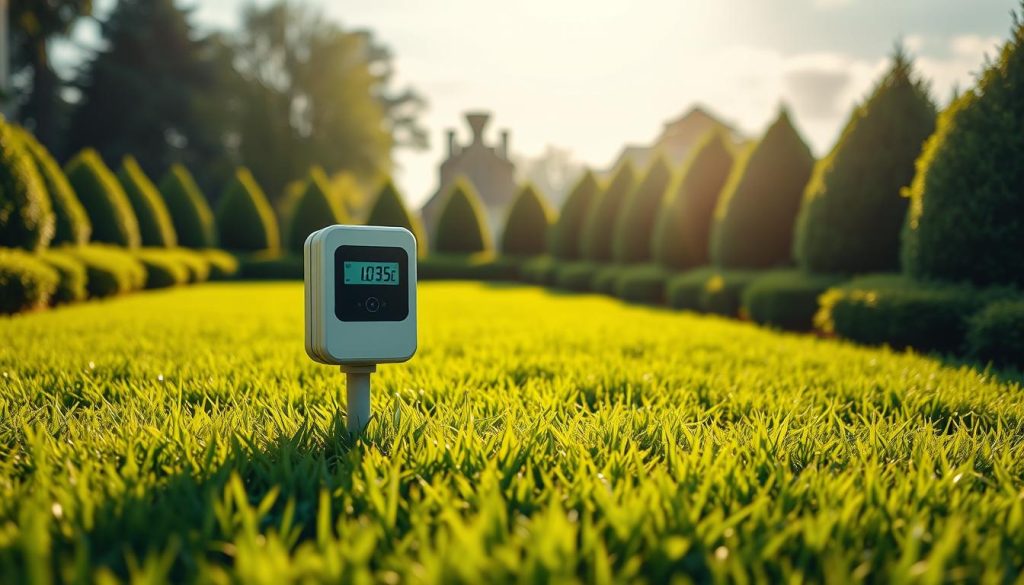
Healthier Plant Growth and Lawn Appearance
Right amount of water makes plants stronger. They grow deeper roots and are more drought-resistant. This also fights off diseases and pests that like too much water.
“My lawn used to have brown patches in summer and moss in winter,” says Sarah Jenkins from Colorado. “Since installing a smart timer, my grass stays uniformly green with 40% less water.”
Time and Effort Savings
Smart watering timers save a lot of time. No more adjusting sprinklers in the rain or changing schedules all the time. They do it all for you.
Homeowners save 2-3 hours a week in growing seasons. This is because they don’t have to monitor and adjust the system manually.
Reduced Water Bills and Long-Term Savings
Smart irrigation saves money too. It costs $100-$300 to start, but you’ll save on water bills in 1-2 years.
| Household Type | Average Monthly Savings | Annual Savings | ROI Timeline |
|---|---|---|---|
| Small Yard (under 2,000 sq ft) | $15-25 | $180-300 | 18-24 months |
| Medium Yard (2,000-5,000 sq ft) | $25-40 | $300-480 | 12-18 months |
| Large Yard (over 5,000 sq ft) | $40-70 | $480-840 | 6-12 months |
Smart watering timers are a smart buy. They save water, improve your lawn, save time, and lower your bills. It’s a win-win for your lawn, wallet, and the planet.
Essential Features to Look for in Smart Watering Timers
Choosing the right smart watering timer is key. It should match your lawn’s needs and your lifestyle. Not all timers are the same, and knowing the differences is crucial. The best ones offer convenience and advanced tech for your lawn’s best care.
Weather Integration Capabilities
Weather-responsive tech is a top feature in smart timers. They connect to weather stations or have sensors for rain, temperature, and humidity. If it rains or looks like it will, they skip watering.
Top models also figure out how much water your lawn needs. They use evapotranspiration rates to adjust watering. This stops overwatering in the rain and underwatering in the heat.
Remote Control and Smartphone Apps
Being able to control your irrigation from anywhere is a big plus. Look for timers with easy-to-use apps. Good apps let you change schedules, turn zones on and off, and get alerts.
Apps should be easy to use. The best ones show your zones and let you make changes easily. You don’t need to be tech-savvy.
Zone-Specific Programming Options
Every part of your yard needs different care. Advanced timers let you set up special programs for each area. This means your veggies get water often, but your trees get it less.
Choose systems with 8-12 zones. This gives you lots of flexibility for different areas.
Water Usage Reports and Analytics
Getting insights from your watering habits is valuable. The best timers give detailed reports on water use, savings, and tips for better watering.
These reports help you see how your watering affects your lawn. They also show how you can save money and water. This makes you a greener homeowner.
Types of Smart Watering Timers for Different Needs
The market has many smart watering timers for different needs. Each type is made for specific irrigation needs and property types. Knowing the differences helps you pick the right one for your lawn care.
Wi-Fi Connected Controllers
Wi-Fi connected smart timers are the most versatile. They connect to your home internet, letting you control your system from anywhere. They also work with weather services and smart home systems like Amazon Alexa or Google Home, and have great mobile apps.
These timers are best for big properties with existing irrigation systems. They need a power outlet and internet but offer the most advanced features.
Bluetooth-Enabled Systems
Bluetooth timers are a good middle choice. They connect to your phone up to 100 feet away, great for smaller places. They’re easy to set up and good for those who don’t want their system online.
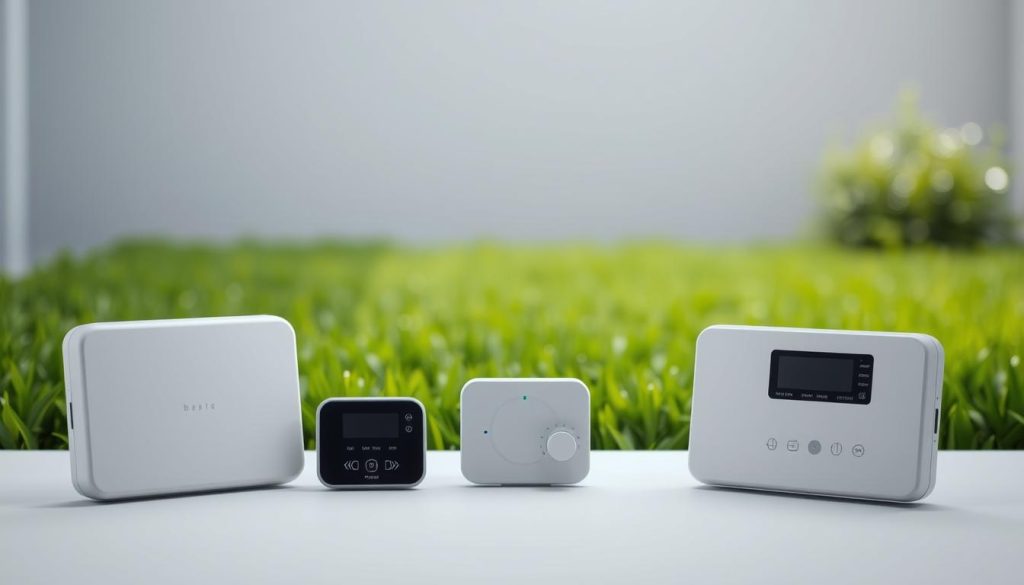
Solar-Powered Options
Solar-powered timers are eco-friendly and easy to install in hard-to-reach areas. They use solar energy, perfect for remote spots or where electrical lines are hard to run.
Most have battery backups for cloudy days. They come with different connectivity options, like Wi-Fi, Bluetooth, or work alone.
Hose Faucet Timer Systems
Hose faucet timers are a budget-friendly choice for those without in-ground systems. They attach to your faucet and control hoses or sprinklers. Many have smartphone control, rain delay, and weather-responsive features.
They’re great for small yards, container gardens, or a first step before bigger systems.
| Timer Type | Price Range | Connectivity | Installation Complexity | Best For |
|---|---|---|---|---|
| Wi-Fi Connected | $100-$300 | Unlimited (via internet) | Moderate | Large properties, tech enthusiasts |
| Bluetooth | $70-$150 | ~100 feet | Easy to Moderate | Small to medium yards, privacy-conscious users |
| Solar-Powered | $80-$200 | Varies by model | Easy | Remote areas, eco-conscious gardeners |
| Hose Faucet | $40-$100 | Varies by model | Very Easy | Small yards, beginners, renters |
Popular Smart Watering Timer Brands and Models
Exploring smart irrigation controllers is easier when you know the top brands and models. Each brand offers unique features and technologies. Let’s look at the best options for saving water in your garden.
Rachio Smart Sprinkler Controllers
Rachio is a top name in smart irrigation timers. Their third-generation controller is a standout. It has Weather Intelligence Plus™, which adjusts watering based on weather forecasts.
The Rachio app is easy to use, letting you control your system from anywhere. Prices range from $149 for an 8-zone controller to $279 for a 16-zone model. Rachio also offers a two-year warranty and great customer support.
These controllers work well with Amazon Alexa, Google Assistant, and Apple HomeKit. They’re great for smart homes.
Orbit B-hyve Smart Irrigation Controllers
Orbit B-hyve controllers are affordable but still smart. They have WeatherSense technology for healthy lawns and water savings. Prices start at $99, making them budget-friendly.
B-hyve controllers connect via Wi-Fi or Bluetooth. Their app gives water usage reports and lets you adjust schedules easily. Orbit offers a one-year warranty and durable, weather-resistant hardware.
Rain Bird Smart Irrigation Systems
Rain Bird has over 80 years of experience in irrigation. Their ST8-WiFi model combines old-school reliability with new tech. Rain Bird’s controllers use advanced algorithms for customized watering.
Prices range from $150 to $230, and they come with a three-year warranty. They’re known for durability and working with Rain Bird systems.
Hunter Hydrawise Smart Controllers
Hunter Hydrawise controllers are for serious landscapers and homeowners. They can save up to 50% of water while keeping lawns healthy. The HC series can grow from 6 to 54 zones.
Priced between $209 and $319, Hunter controllers are a premium choice. They offer a two-year warranty and are known for zone management and water usage analytics.
| Brand | Price Range | Warranty | Standout Feature | Smart Home Compatibility |
|---|---|---|---|---|
| Rachio | $149-$279 | 2 years | Weather Intelligence Plus™ | Alexa, Google, Apple HomeKit |
| Orbit B-hyve | $99-$199 | 1 year | WeatherSense technology | Alexa, Google |
| Rain Bird | $150-$230 | 3 years | Customized watering programs | Alexa, Google |
| Hunter Hydrawise | $209-$319 | 2 years | Predictive Watering™ | Alexa, Control4 |
Installation Guide: Setting Up Your Smart Watering Timer
Getting a smart watering timer is a big step up. It’s easy to set up and brings lots of benefits. This guide will help you install it with ease. Soon, you’ll be able to control your irrigation from anywhere.
Pre-Installation Considerations
Before buying a smart watering timer, check if it fits your sprinkler system. Most work with 24-volt systems, but always double-check. Make sure it has enough zones for your system.
Also, ensure your Wi-Fi is strong and reaches where you’ll install it. Some controllers need 2.4 GHz networks. You’ll need basic tools like screwdrivers and wire strippers.
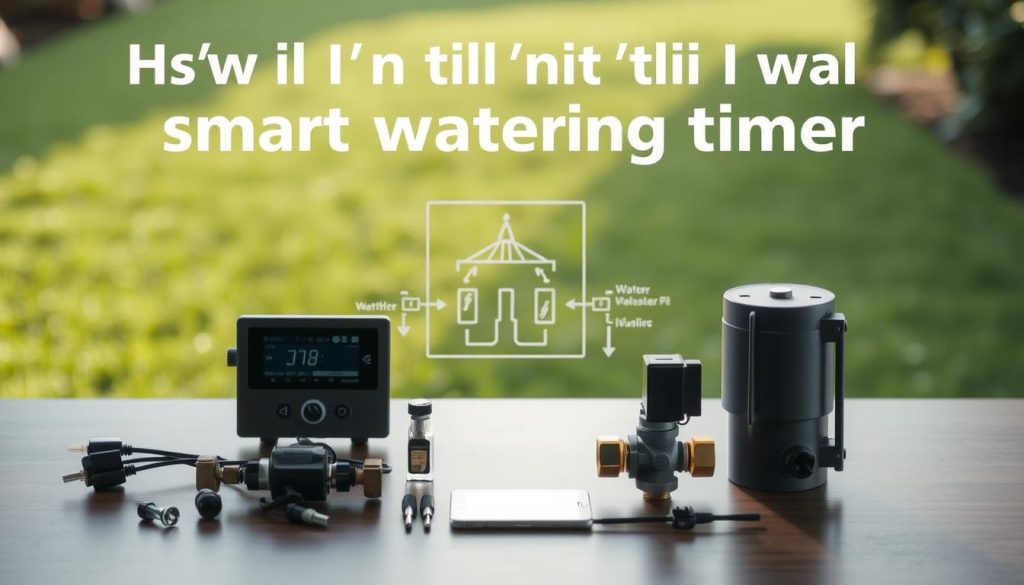
Step-by-Step Installation Process
First, turn off power to your old controller. Take a photo of the wiring before you start. This will help you remember how to reconnect everything.
Remove the old controller and mount the new one. Most timers come with a mounting template. Connect the common wire to “C” or “COM.” Then, attach each zone wire to its number.
If you have a rain sensor, connect it now. Plug in the power adapter or connect the wires to finish.
Connecting to Wi-Fi and Mobile Apps
After installing, connect your device to Wi-Fi. Turn on your controller and follow the instructions to pair it. Download the app and create an account if needed.
The app will help you connect to Wi-Fi. You’ll need to enter your network details. Some controllers might need a direct phone connection during setup.
Once connected, set up basic settings like location and zone details. This helps the system create the right watering schedule for your area.
Professional vs. DIY Installation
Many people install smart timers themselves, but professional help is also common. Think about your comfort with electrical work before deciding.
| Factor | DIY Installation | Professional Installation | Best For |
|---|---|---|---|
| Cost | $0 (equipment only) | $100-$250+ | Budget-conscious homeowners |
| Time Required | 1-3 hours | 1 hour (scheduled) | Busy professionals |
| Technical Support | Manufacturer helplines | On-site expertise | Less tech-savvy users |
| System Optimization | Basic setup | Professional fine-tuning | Complex irrigation systems |
| Warranty Coverage | Hardware only | Hardware and installation | Long-term peace of mind |
If your system is simple and you’re comfortable with wiring, DIY is fine. But for complex systems or if you’re not sure, professional help is best. They can ensure everything is set up right and might even optimize your system.
Programming Your Smart Watering Timer for Optimal Results
Setting up your smart watering timer right is key to a lush, water-saving lawn. These systems are smart, but your input makes them work best. Think of it as a dialogue between you, your lawn, and the controller.
Creating Effective Watering Schedules
Smart irrigation starts with a good watering schedule. Watering between 4-6 AM is best because evaporation is low. This way, water soaks in before it gets hot.
Most smart timers have features like cycle-and-soak. This breaks watering into short intervals. It stops runoff and helps water reach deeper, promoting strong roots.
- Program shorter, multiple cycles instead of one long watering session
- Allow 30-60 minutes between cycles for proper absorption
- Adjust run times based on slope, soil type, and sun exposure
- Include at least one “dry day” between waterings to promote deeper roots
Adjusting for Different Plant Types and Zones
Smart timers are great for zone-specific watering. Your veggies might need more water, while trees prefer less.
Make programs for each zone based on what plants need. For example, water drought-resistant plants less than your lawn. New plants need more water until they’re strong.
Seasonal Programming Adjustments
Lawns need different amounts of water at different times. Most smart timers adjust for this, but check them every quarter.
In spring, water more as plants grow. Summer needs more water but longer soaks. Fall needs less, and winter might need none, depending on where you live.
Utilizing Soil Moisture Sensors
Soil moisture sensors add precision. They tell your controller when the soil is already wet, saving water.
Put sensors 4-6 inches deep in each zone. Most systems let you set moisture levels that stop watering when it’s not needed.
Remember, programming is a process. Watch how your lawn reacts and adjust as needed. The best systems learn and get better over time, just like you learn about your lawn.
Integrating Smart Watering Timers with Home Automation Systems
Connecting your smart watering timer to your home automation network makes lawn care better. It also improves your smart home experience. Modern irrigation controllers work well with smart home systems, letting you control your property from one place.
Compatibility with Smart Home Platforms
Today’s smart watering timers work well with big smart home platforms. Rachio and Orbit B-hyve controllers are compatible with Amazon Alexa and Google Home. RainMachine and some Rachio models also support Apple HomeKit. Samsung SmartThings users can connect with brands like Hunter Hydrawise and Rachio.
This makes managing your home easier. You don’t need to use many apps. Manufacturers often update their systems to add new features.
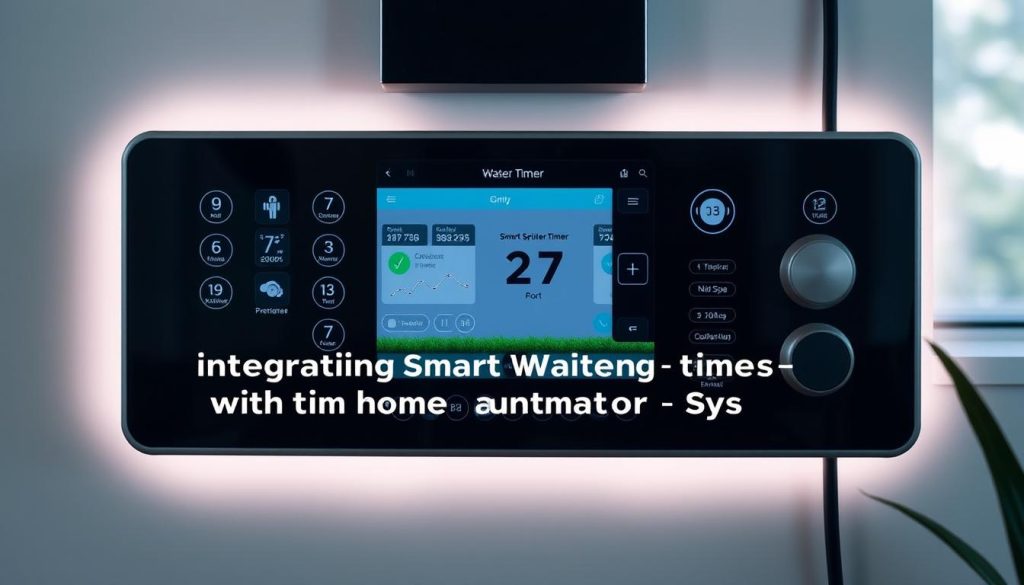
Voice Control Options
Voice commands change how you control your irrigation system. Saying “Alexa, turn on zone two for five minutes” or “Hey Google, stop watering the backyard” is easy. This is great when you’re gardening or having guests over.
Creating Automated Routines
Automated routines are where it gets really cool. You can set your system to skip watering when it sees people outside or when it rains. Some people even link their irrigation to “vacation mode” when they’re away.
Even if you’re not fully into smart home tech yet, these controllers work great on their own. The integration options just add more convenience as you grow your connected home.
Real-World Water Savings: Case Studies and Statistics
Looking at real-world examples shows how effective water management systems are. These systems save a lot of water and money. Let’s see how they help both homes and businesses.
Residential Success Stories
Homeowners in different places have seen big changes after getting smart sprinkler controllers. In Arizona, the Martinez family used 45% less water with a Rachio 3 system. This saved them about $600 a year.
In the Pacific Northwest, Sarah Johnson used a Rain Bird smart controller. She cut her water use by 32% and her plants are healthier. She also sees fewer disease problems.
The Thompson family in Florida had to deal with strict water rules and high bills. They got a smart irrigation system with weather info. This cut their water bill by 38% and kept their lawn green during a dry time.
Commercial Applications and Results
Commercial places see even bigger savings. The Oakridge Community HOA in California updated their irrigation on 15 acres. They used 41% less water and saved $24,000 a year. The system paid off in 14 months.
A park system in Texas put smart controllers in 12 parks. They used 37% less water and the grass looked better. The city saved money and needed less maintenance time.
A hotel chain installed smart water systems in six places. They saved 29% on landscaping water. They got their money back in two years.
Long-Term ROI Analysis
Smart irrigation systems offer more than just water savings. They also save money over time. Here’s what to consider:
| Investment Factor | Typical Cost/Savings | Payback Period | Long-Term Value | |
|---|---|---|---|---|
| Initial Equipment | $150-$300 (residential) | $1,000-$5,000 (commercial) | 12-24 months | Systems typically last 7-10 years |
| Water Savings | 30-50% reduction | Immediate monthly savings | Increases as water rates rise (avg. 5% annually) | |
| Rebates/Incentives | $50-$200 (residential) | $1,000+ (commercial) | Immediate offset to costs | Reduces initial investment burden |
| Landscape Health | Reduced replacement costs | 1-2 growing seasons | Fewer plant losses during extreme weather |
Most people get their money back in two years. Businesses can see even faster returns because they save more. With rising water costs, some users get 300-500% return on investment over their system’s life.
Transform Your Lawn and Lifestyle with Smart Irrigation Technology
Smart watering timers are a big step up in lawn care tech. By using these automated watering devices, you’re not just updating your sprinkler system. You’re also choosing a greener way to care for your yard.
These timers save water and help your lawn grow strong and green. You’ll also cut down on your water bills, which can help pay for the timers over time. Plus, you won’t have to spend time adjusting sprinklers manually.
Ready to upgrade? First, look at your current irrigation system and what your lawn needs. Look for intelligent irrigation timers that fit your yard size and plant types.
See if your local water district offers rebates for water-saving devices. Many do! You might also want to talk to a lawn care expert who knows about smart irrigation.
By choosing this tech, you’re part of a growing group of eco-conscious homeowners. Your lawn will look great, your wallet will stay happy, and you’ll feel good about saving water.

